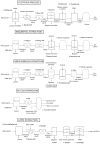Guayule (Parthenium argentatum A. Gray), a Renewable Resource for Natural Polyisoprene and Resin: Composition, Processes and Applications
- PMID: 33513965
- PMCID: PMC7865983
- DOI: 10.3390/molecules26030664
Guayule (Parthenium argentatum A. Gray), a Renewable Resource for Natural Polyisoprene and Resin: Composition, Processes and Applications
Abstract
Natural rubber is an essential material, especially for plane and truck tyres but also for medical gloves. Asia ranks first in the production of natural rubber, of which the Hevea tree is currently the sole source. However, it is anticipated that this source alone will not be able to fulfill the growing demand. Guayule, a shrub native to northern Mexico and southern United States, may also contribute. This plant not only contains polyisoprene, but also resin, a mixture of lipids and terpenoids. This review summarizes various aspects of this plant, from the usage history, botanical description, geographical distribution and cultivation practices, down to polyisoprene and resin biosynthesis including their distribution within the plant and molecular composition. Finally, the main processes yielding dry rubber or latex are depicted, as well as the properties of the various extracts along with economic considerations. The aim is to provide a wide picture of current knowledge available about this promising crop, a good feedstock candidate for a multiple-product biorefinery.
Keywords: green chemistry; green extraction; green reagents; guayule; latex; polyisoprene; rubber.
Conflict of interest statement
The authors declare no conflict of interest.
Figures












References
-
- Minh-Thu D.-A. La Chimie du Végétal, Pour du Biosourcé au Quotidien. [(accessed on 11 May 2020)]; Available online: http://www.lactualitechimique.org/Ressources/AC-Decouverte/La-chimie-du-....
-
- Seidel A., Kirk R.E., Othmer D.F. Kirk-Othmer Encyclopedia of Chemical Technology. Wiley-Interscience; Hoboken, NJ, USA: 2007. pp. 1–26.
-
- Pioch D., Palu S. Du Caoutchouc Naturel en Europe. [(accessed on 22 November 2019)]; Available online: https://www.pourlascience.fr/sd/biologie-vegetale/du-caoutchouc-naturel-....
-
- Cornish K., Brichta J.L., Yu P., Wood D.F., Mcglothlin M.W., Martin J.A. Guayule Latex Provides a Solution for the Critical Demands of the Non-Allergenic Medical Products Market. Agro Food Ind. Hi Tech. 2001;12:27–32.
-
- Bajaj Y.P.S. Medicinal and Aromatic Plants IX. Springer Science & Business Media; Berlin/Heidelberg, Germany: 2013.
Publication types
MeSH terms
Substances
LinkOut - more resources
Full Text Sources
Other Literature Sources

